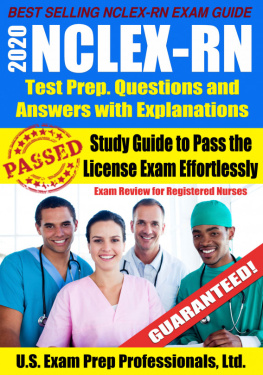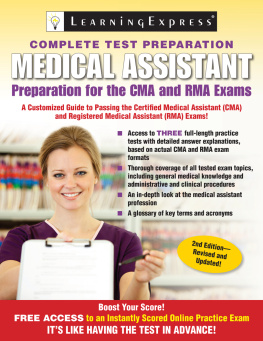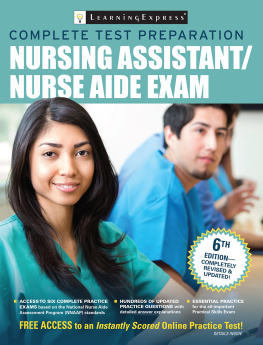Contents
Guide
Page List

Also from Kaplan
Anatomy Coloring Book
Anatomy Flashcards
ATI TEAS Prep Plus
EMS Dosage Calculation
EMT Exam Prep
National Registry Paramedic Prep
Nursing School Entrance Exams Prep
Ultimate Medical Mnemonic Comic Book

This publication is designed to provide accurate information in regard to the subject matter covered as of its publication date, with the understanding that knowledge and best practice constantly evolve. The publisher is not engaged in rendering medical, legal, accounting, or other professional service. If medical or legal advice or other expert assistance is required, the services of a competent professional should be sought. This publication is not intended for use in clinical practice or the delivery of medical care. To the fullest extent of the law, neither the Publisher nor the Editors assume any liability for any injury and/or damage to persons or property arising out of or related to any use of the material contained in this book.
RMA is an examination of American Medical Technologists (AMT), which neither sponsors nor endorses this product. All organizational and test names are trademarks or registered trademarks of their respective owners.
CMA is an examination of the American Association of Medical Assistants (AAMA), which neither sponsors nor endorses this product. All organizational and test names are trademarks or registered trademarks of their respective owners.
2022 by Kaplan, Inc.
Published by Kaplan Publishing, a division of Kaplan, Inc.
1515 W. Cypress Creek Road
Fort Lauderdale, FL 33309
All rights reserved. The text of this publication, or any part thereof, may not be reproduced in any manner whatsoever without written permission from the publisher.
10 9 8 7 6 5 4 3 2 1
ISBN-13: 978-1-5062-7820-9
Kaplan Publishing books are available at special quantity discounts to use for sales promotions, employee premiums, or educational purposes. For more information or to purchase books, please call the Simon & Schuster special sales department at 866-506-1949.
Contents
For Test Changes or Late-Breaking Developments
kaptest.com/retail-book-corrections-and-updates
The material in this book is up-to-date at the time of publication but the test makers may have instituted changes to the tests since that date. Be sure to carefully read the materials you receive when you register for the test. If there are any important late-breaking developmentsor any changes or corrections to the Kaplan test preparation materials in this bookwe will post that information online at kaptest.com/retail-book-corrections-and-updates.
Nancy Szwydek, MPH, RN, RHIA, RMA, CMAC, CRAT, has more than 40 years experience working in the health care field in both clinical and administrative capacities. She is currently assistant dean, director of accreditation, and online department chair for the Health Information Management, Health Informatics, and Billing & Coding programs at Purdue University Global. In addition, Ms. Szwydek is a MAERB board member, an accreditation peer reviewer for MAERB/CAAHEP, and an item and module writer for medical assisting exams for a national credentialing organization. For over 10 years, Ms. Szwydek served as chair of the Medical Assisting program at Kaplan University, where she was instrumental in completing the first self-study program and achieving programmatic accreditation for the program through CAAHEP.
Ms. Szwydek holds a master of public health degree and a certified medical assistant certificate (CMAC). She is a registered nurse, a registered health information administrator (RHIA), a registered medical assistant (RMA), and a certified rhythm analysis technician (CRAT).
Kaplan thanks the following experts for their contributions to this book:
Joanna Holly, MS, RN, CNA
Kathleen A. Locke, CMA
Diann L. Martin, PhD, RN
Margaret Riley, BSN, RN
Kari Williams, BS, DC
If you are reading this book, the chances are good that you are preparing for your CMA, RMA, or other nationally recognized credentialing exam. You probably have completed, or soon will complete, a program of study in medical assisting. Congratulations on your decision to seek certification or registration. In addition to demonstrating your expertise, these credentials are becoming increasingly important to employers. While the exams may seem daunting, this book can help you prepare. Just follow the program of study outlined here.
STEP 1: READ PART 1 (BASICS)
, you will find Kaplans special test strategies and advice for the day of the exam. You can trust Kaplan to bring you the best strategies and the most up-to-date information on your test.
STEP 2: TAKE THE DIAGNOSTIC TEST
The 30-question diagnostic test will help you determine where your strengths and weaknesses lie. You can use this information to shape your approach to the review chapters, spending more time with the topics that need more review. Because the exams cover a broad range of content, this focused approach will help you make the most of your study time.
STEP 3: READ THE REVIEW CHAPTERS
review the general, administrative, and clinical topics on the credentialing exams. Each chapter concludes with review questions to help you gauge what you have learned. Be sure to read the answer explanations for all questions, including those you answered correctly. You often can pick up new information on many topics while reading about why incorrect answer choices are incorrect.
STEP 4: TAKE THE FULL-LENGTH PRACTICE TEST
When you are nearing your exam date, take Kaplans full-length practice exam. This exam mimics the format of the actual CMA exam and also provides great practice for the other credentialing exams. It will help you build your stamina for the real test and give you a good sense of your level of preparation. Detailed answer explanations follow the exam, and these can help you understand why you got off track on a particular question.
The Resources section in the back of this book contains a wealth of information on searching for jobs and links to professional organizations and publications. It also includes the new Reference Guide, with need-it-now resources to help you prepare for your credentialing exam and to use in your career in medical assisting. The new Reference Guide includes: normal vital signs, normal diagnostic lab values, household conversions, EKG leads and interpretations, order of draw, needle gauges and angles for injection, and key insurance terms.
Best of luck on your exam, and best wishes in your career as a medical assistant!
According to the U.S. Bureau of Labor Statistics, medical assistants are in high demand, and that demand is expected to keep growing. Job growth for medical assistants is attributed to an aging baby boom population, a decrease in the average hospital stay time, and an increase in preventive care initiatives. Acute and chronic diseases will result in increased office visits, and health care providers will seek additional medical assistants to perform clinical and administrative duties in order to see more patients.









